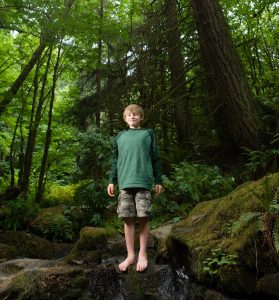I am a barefooter, which means I go barefoot pretty well everywhere and throughout much of the year. I became interested in barefooting around junior high and have since studied the health benefits associated with it. For myself, I have fewer muscle spasms and other benefits when going without footwear. For most people that walk, especially kids, there are many more advantages to having free feet.
Why Barefoot
If you have had a cast on an arm or leg, you know the muscles get weak from not being used. When the cast is removed, the limb needs to be conditioned for use again. Shoes are essentially casts for your feet; and they need to be removed.
When a child is born, their feet are primarily made out of cartilage. As the baby grows and develops, so do their feet. The cartilage gradually forms into bone that will be in place for his or her entire life. This growth isn’t complete until the late teens and can have an impact as an adult.
 Most footwear restricts the movement of the foot and acts like a cast. Muscles in the arch and ankle don’t strengthen and rely on support from a shoe. When walking or running, toes are designed to spread out in order to absorb weight. This isn’t allowed with most footwear and the foot conforms to the shape of the shoe.
Most footwear restricts the movement of the foot and acts like a cast. Muscles in the arch and ankle don’t strengthen and rely on support from a shoe. When walking or running, toes are designed to spread out in order to absorb weight. This isn’t allowed with most footwear and the foot conforms to the shape of the shoe.
Take a close look at the picture on the left, click on it to make it larger. You can see this boy’s toes are curled over and have little to no space between them. This is a  result of consistently wearing shoes. The foot is not allowed to spread as it takes weight when walking and ill-fitting footwear causes growth problems. Shoes also make a person walk incorrectly so that the ankle, knees, hips, and back are not aligned correctly. Look at your own, or your child’s, feet and you will likely see the same problems as pictured here. The illustration on the right shows a side-by-side comparison of misshapen feet and those that have been allowed to go barefoot.
result of consistently wearing shoes. The foot is not allowed to spread as it takes weight when walking and ill-fitting footwear causes growth problems. Shoes also make a person walk incorrectly so that the ankle, knees, hips, and back are not aligned correctly. Look at your own, or your child’s, feet and you will likely see the same problems as pictured here. The illustration on the right shows a side-by-side comparison of misshapen feet and those that have been allowed to go barefoot.
Where Can I Go Barefoot
The most trouble adults have with going barefoot is overcoming social norms and misconceptions of non-existent laws. This is usually not as much of a case for children, especially if they have well informed parents helping them along. Any activity a child does with shoes can be done barefoot, in some instances it can even be performed better. In fact, a child can be barefoot about 70-95% of the time. Look through these following situations to see  children doing them barefoot and how you can encourage them to start.
children doing them barefoot and how you can encourage them to start.
Shoes do not allow feet to move as God designed them. Going barefoot allows for proper walking which helps prevent many foot problems. Issues such as athlete’s foot actually get worse in the environment of closed toe shoes. The best solution is to let them be bare.
For children that are accustomed to wearing shoes, it may take time for them to adjust to going barefoot. The younger they start, the better. It is an easy, free option that will have life-long benefits for them, especially if they continue to go barefoot as an adult. Better yet, as a responsible adult reading this web site, you can also start going barefoot with your child and help encourage them in this new adventure.
Barefoot Resources
Further information can be found on the web sites below. You can get more assistance on how to let your feet be free and current laws, regulations, and other information. When it comes to going barefoot, you need to “Just Do It” (pardon the pun)!
Five Convincing Reasons to let Your Kids go Barefoot

